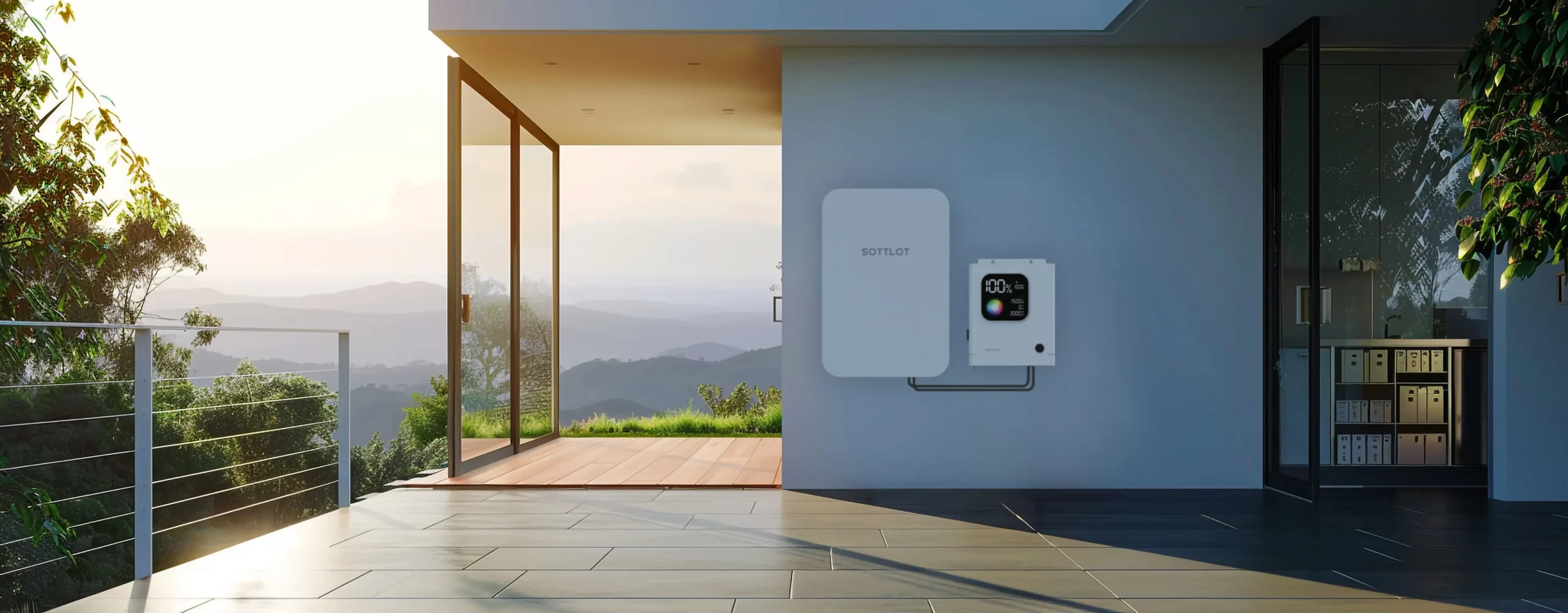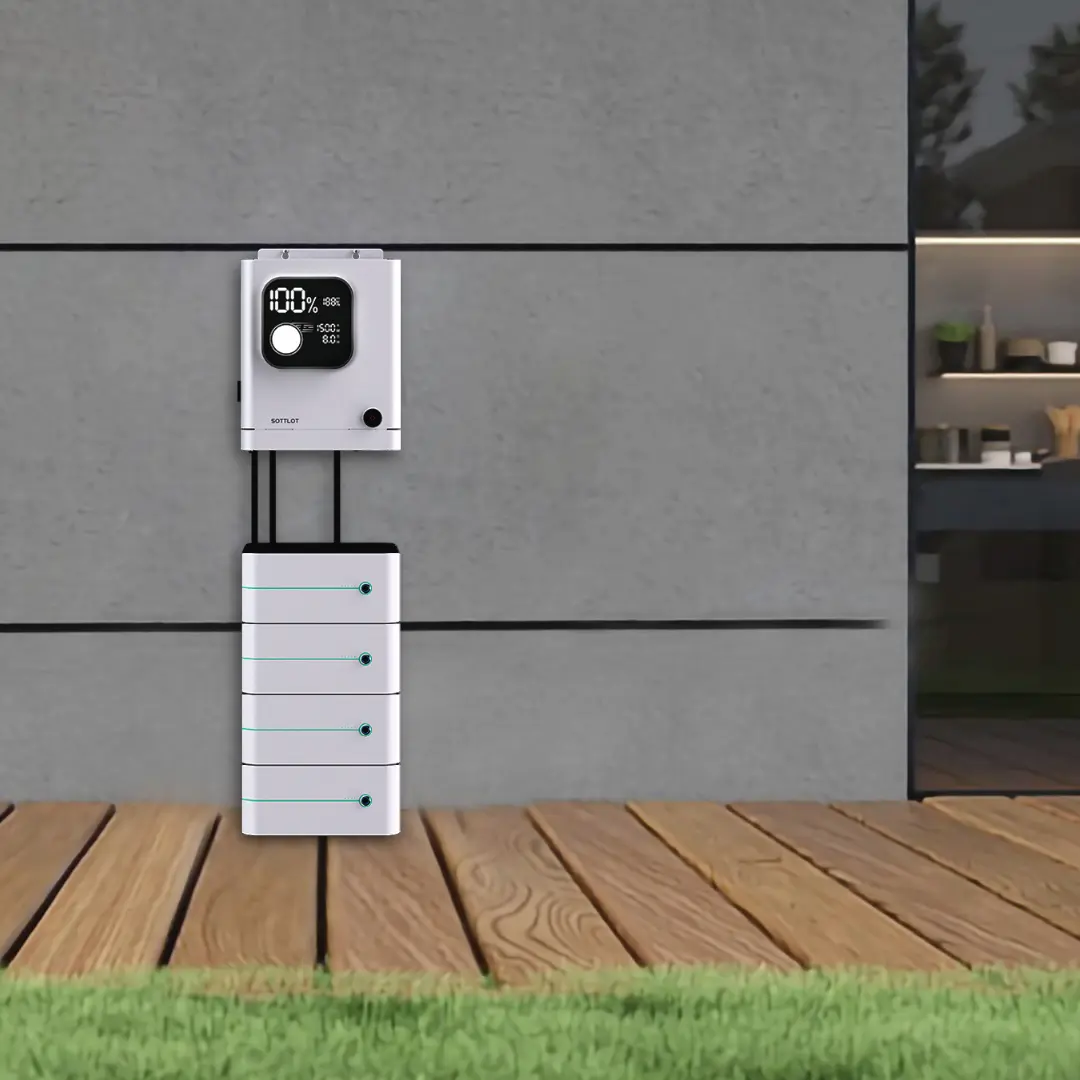In recent years, home energy storage solutions have become a popular choice for consumers around the world. The growing use of distributed energy sources, such as solar and wind, combined with issues like grid instability and rising energy costs, has made home energy storage batteries a standard feature in many homes. Whether it’s to enhance energy independence or optimize energy use through efficient storage, the value of energy storage batteries cannot be ignored.
However, with a wide range of energy storage batteries available on the market, there are significant differences in performance, lifespan, safety, and price. So, how can homeowners select the most suitable product? This article will analyze the main types and characteristics of energy storage batteries in detail, with a focus on lithium iron phosphate (LiFePO4) battery technology, which is currently the most widely used for home energy storage. We will also introduce Sottlot’s DPE-5K energy storage battery to help you make an informed choice in a complex market.

Different Types and Characteristics of Energy Storage Batteries
The choice of a home energy storage battery directly impacts the efficiency and long-term cost of electricity, so it’s important to understand the advantages and disadvantages of different technologies. Common types of energy storage batteries on the market today include lead-acid batteries, lithium batteries, sodium-sulfur batteries, and flow batteries, each with its own performance and application differences.
1. Lead-Acid Batteries: Traditional Energy Storage Technology
Lead-acid batteries are one of the oldest types of batteries and are widely used in automotive starting and uninterruptible power supply (UPS) applications.
Advantages:
- Low cost: Lead-acid batteries have a low initial investment, making them a budget-friendly option for families.
- Mature technology: After years of development, lead-acid battery technology is stable, and maintenance techniques are relatively simple.
Disadvantages:
- Short lifespan: The cycle life of lead-acid batteries is typically only 300-500 cycles, and frequent charging and discharging rapidly reduce performance.
- Requires regular maintenance: Users must replenish the electrolyte and clean the terminals regularly.
- Large size and heavy weight: With low energy density, these batteries require a lot of space, making them unsuitable for space-sensitive homes.
Lead-acid batteries are best for users with limited budgets or scenarios where electricity demand is low. However, they are being increasingly replaced by more advanced lithium batteries in the energy storage market.
2. Lithium Batteries: A High-Performance Home Energy Storage Option
Lithium batteries have become the mainstream choice for energy storage in recent years. Their main advantages include high energy density, long life, and light weight, making them ideal for home energy storage systems that require high efficiency and performance.
Advantages:
- High energy density: Lithium batteries can store more power in a smaller volume, occupying less space.
- Long lifespan: Lithium batteries typically offer over 2,000 cycles, with some advanced models exceeding 4,000 cycles.
- Lightweight: Easier to install and transport compared to lead-acid batteries.
Disadvantages:
- Higher cost: While lithium batteries have a higher initial investment, their long life and low maintenance costs can offset the higher upfront price over their lifespan.
Among lithium batteries, lithium iron phosphate (LiFePO4) batteries are particularly well-suited for home energy storage due to their superior safety and longevity.
3. Sodium-Sulfur Batteries: Industrial-Grade Energy Storage
Sodium-sulfur batteries are typically used for large-scale energy storage, particularly in industrial projects that require long-term energy storage.
Advantages:
- Large-scale energy storage capacity: Ideal for scenarios with long, continuous discharge times.
- High cycle life: Can withstand many charge and discharge cycles.
Disadvantages:
- High operating temperatures: These batteries must operate in high-temperature environments, which makes them unsafe for residential use.
- Expensive: High manufacturing and maintenance costs make them unsuitable for home use.
Although sodium-sulfur batteries are outstanding in industrial applications, they are not suitable for home use due to their complexity and safety requirements.
4. Flow Batteries: Cutting-Edge Technology but Not Yet Widely Adopted
Flow batteries are an emerging technology that stores energy through the circulating flow of electrolyte, offering high scalability.
Advantages:
- Suitable for large-scale energy storage: The separation of energy storage and power provides high flexibility.
- Long lifespan: Flow batteries are designed for long-term use.
Disadvantages:
- Large footprint: They require specialized liquid storage equipment, taking up more space.
- Complex technical requirements: Flow batteries have complex system maintenance needs and high costs.
Flow batteries are primarily used in research and industrial applications, and their use in home energy storage is still limited.
Why Does the Home Energy Storage Market Favor Lithium Batteries?
Lithium batteries, especially lithium iron phosphate (LiFePO4) batteries, have become the mainstream choice for home energy storage due to their high efficiency, safety, and long lifespan. While they have a higher initial cost compared to traditional lead-acid batteries, their low maintenance and longer lifespan make them a better investment over time.
LiFePO4 Battery Technology: The Best Choice for Safety and Longevity
Among the various lithium battery technologies, LiFePO4 batteries stand out for their superior safety and durability.
Safety:
- LiFePO4 batteries offer excellent thermal stability, preventing thermal runaway and eliminating the risk of fire.
- The built-in Battery Management System (BMS) provides overcharge, over-discharge, and temperature protection for added safety.
Lifespan:
- LiFePO4 batteries have a cycle life of over 4,000 cycles, which is up to 10 times longer than that of lead-acid batteries.
Case Study: DPE-5K
Sottlot’s DPE-5K energy storage battery features a high-efficiency LiFePO4 cell combined with an intelligent BMS, offering excellent safety and stability.
- Expandability: The DPE-5K supports parallel capacity expansion and can connect up to 16 units to meet large-scale capacity demands.
How to Choose the Right Energy Storage Battery Based on Your Needs
- Capacity Demand: Choose a battery that meets your peak demand based on your household’s daily electricity consumption. For most homes, the 5kWh capacity of the DPE-5K is ideal.
- Safety and Longevity: Prioritize batteries with LiFePO4 technology for high safety and low maintenance.
- Expandability: Consider your future electricity needs and choose a battery that supports expansion. The DPE-5K can be expanded to up to 16 units to meet long-term energy demands.
LiFePO4 battery technology is undoubtedly the best choice for home energy storage when considering performance, safety, and longevity. Energy storage batteries like Sottlot’s DPE-5K not only offer flexible expansion options but also incorporate cutting-edge safety management technology to provide homeowners with an affordable and efficient energy storage solution.
Choose the DPE-5K for your home energy management and embrace a more efficient and safer energy future!




